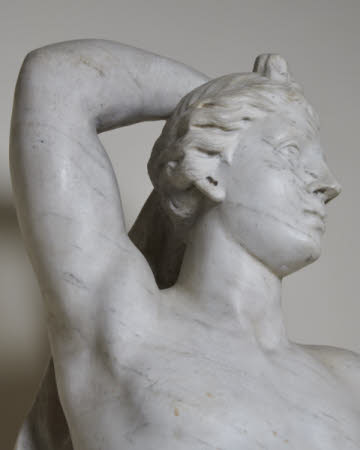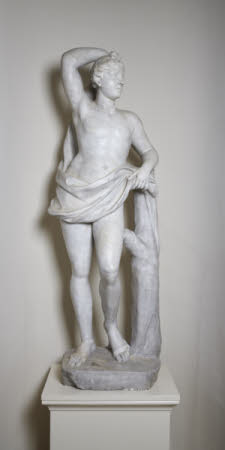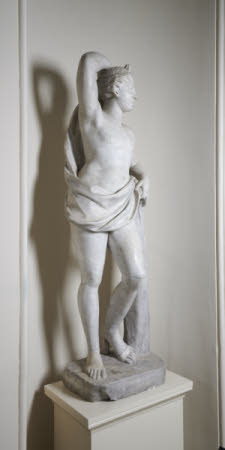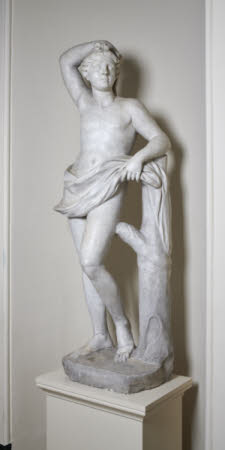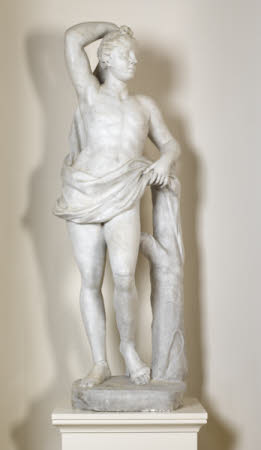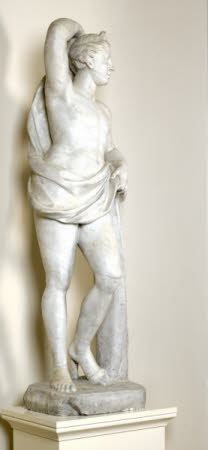The Apollino
Italian School
Category
Art / Sculpture
Date
c. 1700 - 1800
Materials
Marble
Measurements
1790 x 630 x 450 mm
Place of origin
Italy
Order this imageCollection
Mount Stewart, County Down
NT 1542338
Summary
Sculpture, marble; the Apollino, after the antique; Italian; c. 1700-1800. A more than full-scale copy of a once celebrated Roman sculpture, today in the Uffizi in Florence, which depicts the god Apollo. This version is not so much a copy as a variant, with some quite significant differences from the Roman figure. Another copy at Mount Stewart is more faithful to the original.
Full description
A marble statue of the Roman marble statue known as the Apollino or ‘little Apollo’, which has been one of the highlights of the Tribuna in the Uffizi galleries since the late eighteenth century. The god stands with his weight upon his right foot, his torso slightly twisted as he looks towards his left. He leans with his left elbow upon a tree stump, whilst his right arm is raised and rests on the back of his head. His hair arranged into a bow at the front. On an integral base with rounded edges. The marble is impure, containing extensive streaks. Unlike the Roman marble version of the Apollino, who is shown naked, here Apollo is partly covered by a length of drapery, one end of which he holds in his right arm, from which it passes down Apollo’s back and across his front, before being caught up with his left hand, the remainder falling over the top of the tree trunk. Another variation from the Uffizi figure is the absence of the quiver, suspended from the tree trunk in the statue in the Uffizi. Apollo, god of the sun, and also of music and lyric poetry, was sometimes also depicted as a hunter, with a bow and a quiver of arrows. He used his bow to slay the serpent Python with ‘a thousand arrows’ in an episode recounted in Ovid's Metamorphoses (I. 439-49), and in another story in which Apollo and his sister Diana slew the children of Niobe, who had boasted that she had outdone their mother, Leto, in her number of offspring. In the Roman marble statue in the Uffizi, generally thought to be a copy of a fourth-century B.C. Greek sculpture of a type known as the Apollo Lykeios or ‘Lycian Apollo’ (Mansuelli 1958-61, I, pp, 74-76, no. 46; Haskell and Penny 1981, pp. 146-48, no. 7), the bow that Apollo would originally have held in his left hand and the quiver on the tree trunk refer to these episodes. Otherwise, though, the sculpture is a display of languid male beauty. It may have been discovered in the seventeenth century, but was recorded in 1704 in the Villa Medici in Rome, in a compendium of famous statues in Rome published by Paolo Alessandro Maffei. The illustration suggests that most of the restorations seen on the sculpture today had probably already been done by that time. In 1769-70 the statue was moved to Florence, along with the celebrated group of sculptures of Niobe’s children. It was shortly afterwards placed in the Tribuna of the Uffizi, where it may still be seen today. Although interest would greatly diminish later in the nineteenth century, during the eighteenth and early nineteenth centuries the Apollino was one of the most highly regarded sculptures in the Uffizi, even thought to compare with the Venus de’Medici. The poet Percy Bysshe Shelley wrote especially lyrically on the figure, praising the ‘spirit-like lightness, the softness, the flowing perfection of these forms.’ Shelley went on ‘The countenance though exquisite lovely and gentle is not divine. There is a womanish vivacity of winning yet passive happiness and yet a boyish inexperience exceedingly delightful. Through the limbs there appears to flow a spirit of life which gives them lightness… The neck is long yet full and sustains the head with its profuse and knotted hair as if it needed no sustaining.’ (Shelley 1879, p. 37, no. XLVIII). This variation on the famous antiquity,probably made in the eighteenth century, is somewhat larger than the original and, with the addition of the drapery and the absence of the quiver, differs from it quite significantly. It is also made from a curious streaked marble, possibly Proconnesian marble, quarried on the island of Marmara, and known by the Roman stoneworkers as marmo cipolla or onion marble, after the pungent smell of hydrogen sulphide it emits when cut. Jeremy Warren September 2022
Provenance
On loan from the Estate of the Marquess of Londonderry
Credit line
Estate of the Marquess of Londonderry
Makers and roles
Italian School, sculptor
References
Shelley 1879: Harry Buxton Forman, ed., Notes on Sculptures in Rome and Florence together with a Lucianic fragment and a criticism of Peacock’s poem “Rhododaphne”, by Percy Bysshe Shelley, London 1879 Mansuelli 1958-61: Guido Mansuelli, Galleria degli Uffizi. Le sculture, 2 vols., Rome 1958-61 Haskell and Penny 1981: Francis Haskell and Nicholas Penny, Taste and the Antique, The Lure of Classical Sculpture 1500 - 1900, New Haven and London, 1981, 7
